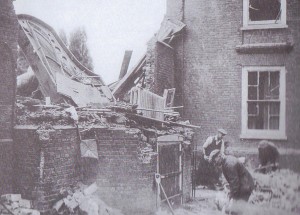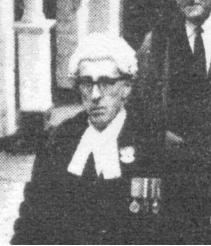The late John Smith’s account of his time as Rye Town Clerk. Reprinted from “Rye Memories” with thanks to Jo’ Kirkham. The War Years and Beyond
I started work in the Rates Office, then at 107 High Street (now the Easton Rooms) in 1936. Mr. Cyril Powell, Rating and Valuation Officer was my boss and Mr. Ambrose Huxstep my Senior. Mr. Huxstep and I were responsible for writing all rates demands and other Council bills, collecting Councils rents and other monies and accounting for it all. The Borough Surveyor’s office was on the upper floors of 107 High Street and Capt. E.P. Dawes, the part-time Town Clerk had his office at Bank Chambers. My post as Assistant Collector was necessary, inter alia, because of the building of the new Council houses at Kings Avenue and New Road with four more in Military Road. All the rent collection was done on foot starting on Monday morning with the twenty houses in Udimore Road/Cadborough Cliff, then Ferry Road, Cyprus Place, Carlyle Place, Alma Place, South Undercliff, Lucknow Place, Bedford Place, Fishmarket Road, Bridge Place, Spring Place, Waterloo Place, Spring Crescent, Daniel Place, Wellington Terrace and the Almshouses and then to Kings Avenue and New Road. This was not, I hasten to add, all on Monday, but spread over the first two and a half days of the week. Some tenants paid their rents at the office. Memory is a trick thing, but I don’t seem to remember many wet days when I went collecting – one was enough!
As all rate demands and other accounts were hand written, the three of us were very much aware of the people with whom we were dealing and the Council benefited from our knowledge in that it seemed to be a matter of honour to ensure that arrears of money due to the Council were absolutely minimal at the end of the financial year. Any debtor received a personal call – sometimes more than one – from the senior or the boss, to ensure that debts were paid at the due time.
In addition to the jobs I have already mentioned, I typed letters and valuation forms and until Mr. Bill Breeds was taken on as a temporary employee specifically for the work, I surveyed existing houses, drawing plans of the accommodation. This was to be in readiness for a Rating Revaluation to take place in what turned out to be the first year of the War. Audit of the Council’s Accounts was in part (Rating and Housing under the 1919 and later Housing Acts), by the District Auditor – who always seemed to be able to time his visit for Rye Cricket Week, when he went to watch with the Town Clerk, leaving the junior auditors to do the work! – and partly by what was known as Elective Audit. Two Auditors were elected by the ratepayers (the voters, not an association), and together with one appointed by the Mayor, they audited the remainder of the Corporation Accounts, receiving a fee for the work. The system was considered less than satisfactory and moves were made by the more progressive Councillors, led by C.M. Bellhouse, to adopt the District Audit System for the whole of the accounts. After much discussion this came into force from the 1st April 1939, with Mr. Powell being appointed Financial Officer and me as Accountancy Assistant.
The War was looming on the horizon; the Borough Surveyor had assumed responsibility for Civil Defence and he needed more office accommodation, so the Finance and Rates Department moved early in the War to the Mermaid Tea Room. We were allowed to use the Mermaid Hotel cellar as our Air Raid Shelter. On 18th August 1940 the rear of the Mermaid Hotel suffered bomb damage from the stick of bombs that destroyed Godfreys Row, houses in the Mint (both sides), the Second House in Mermaid Street and the Garden Room at Lamb House – we continued to collect rents and rates!
At the outbreak of War, Rye received evacuees from London. Mr. Powell was the Billeting Officer, so on 3rd September 1939 we were in the lower hall at the Monastery dealing with the billeting of the evacuees amongst whom were some rather pregnant ladies, a number of whom were accommodated in the Second House (in Mermaid Street). The First House was the sick bay for the evacuees. Roan School boys, billeted in Ockman House, were supervised by two ladies one of whom was a Miss Ponsford. My parents took in a London woman and her daughter. The office staff had been reinforced, before our move to the Mermaid Tea Rooms, first by the arrival of Wilfred Bullet who then obtained a Civil Service post so he was replaced by Don Foord. The next problem involved the return of the London evacuees in the early summer 1940, followed by the evacuation of the Rye school children in June. I acted as escort on an East Kent bus which picked up Rye Grammar School pupils, starting first at Staplecross and then at various places en-route, bringing them to Rye Station.
I had joined the L.D.V. soon after its formation and marching drill of the Cricket Salts and night duty at Point Hill, manning a telephone, kept me out of mischief. I had learned to slow march by the time my occupation became de-reserved on August 1st 1940. I was quickly called for a medical at the Drill Hall at Hatherley Road, St Leonards. On the Sunday that Lamb House Garden Room was bombed, I had begun firing practice with the Home Guard at the Rages near Camber Castle

the Garden Room at Lamb House. Benson’s grand piano can be seen amongst
the wreckage.
Picture from Jo Kirkham’s “Rye’s War”
and was changing out of my uniform when the bombs were dropped, filling Market Street, where we had lived since 1936, with clouds of dust. I quickly descended 2 flights of stairs at Town Hall Cottage, arriving at the bottom with only one leg in my trousers! Travel in the Rye area was only allowed if you lived here. A policeman was always at Rye Station to check passengers off the trains.
I arrived home early one evening in September to find my call-up papers awaiting me. They had apparently been delayed in the post by the London air raids and I arrived at Arborfield, near Reading, on 16th September to join the Royal Artillery. After my basic training which, because of learning to march in the Home Guard, I found easier than some of my companions, our unit served in ADGB (Air Defence Of Great Britain) in England, Wales and Scotland. In 1942 the Battery was sent to the R.A. Depot at Woolwich where it was reformed and I found myself on board the ‘Esperance Bay’ at Avonmouth, whence we travelled via Sierra Leone to Cape Town. At this latter place we were allowed shore leave and told our final destination – the Falkland Islands – where we disembarked by tenders at Port Stanley as the artillery arm of the Falkland Island Force. Bleak the country may have been, but the people were most patriotic and very kind to us.
On our return to England early in 1944 we were sent to Grasmere for the break-up of our unit, all fit men being transferred to the infantry, although army “tradesmen” such as fitters, clerks, cooks and others were sent to the R.A. Depot at Woolwich or, in my case, to an R.A.Battery at Dunkirk, Kent. As I was surplus to establishment, I soon found myself on a draft, via the R.A. Depot to Egypt where the R.A. Depot at Almaza eventually posted me to the Hong Kong and Singapore Royal Artillery (the only Indian Regiment in the British Army) about to return to India after service in the Western Desert. Disembarking at Bombay we were sent to Mehgaon in Central Province where we were soon training for the invasion of Malaya. The dropping of the atomic bombs in Japan possibly saved me from injury or even death which might have resulted had we had to continue our role in the invasion of Malaya. Eventually we reached Deolali (near Bombay) through which camp we were sent on our way home. Arriving at Liverpool I had to go to Guildford for my demob suit, reaching home in March or April 1946.

After what I considered a well-earned holiday, I returned to work. At this time the Town Clerk’s and Finance Department shared 2 High Street. I was intrigued to find that my first job was to complete the financial claims for billeting work carried out before I went in the Army! The Borough Surveyor’s Office was at 10 High Street and this was rented, as was No. 2. Eventually the Council started to explore the possibility of all Departments being housed in the same building and the former Collegiate School was one property which was considered.
On 26th June 1948 at Christ Church, Blacklands, Hastings, I was married to Miss Phyllis Tuff who I had met through an introduction by a mutual friend nearly 2 years previously. We have two sons, David born on 23rd of June at St. Helens Hospital, Hastings and Michael, born on 18th of December 1951 at 81 Marley Road, Rye. Since 1963 we have lived at 75 Ferry Road, Rye, a house formerly occupied by the Gafford family. Mr. C. A. Gafford was the secretary of the Rye Gas Co. and an Alderman of the old Rye Borough Council. His daughter Ethel, from whose estate we bought the house, will be remembered as the Manager of the Rye Labour Exchange. I was fortunate enough never to have been out of work, but I have one memory of the Labour Exchange when it was in Wish Street (at the former Mission Room where Miss James’ School was held), for it was there I went to register for National Service.
On the death of the last member of the Bowen family in 1949 or 1950, Magdala House in Ferry Road (now serving in a greatly different form), which had been rented by them from the Borough Council, became available. After alterations, the Surveyor’s Dept. were the first to move in, as the lease of 10 High Street had expired.
Finally, in 1955 the Clerk’s and Finance Departments vacated 2 High Street and were also accommodated at Magdala House. In 1954 I had been appointed as the Councils Accountant, continuing in that capacity until I was appointed Chief Financial Officer and from 1966, in addition, as Town Clerk. I held this joint appointment until the reorganisation of local government resulted in the abolition of Rye Borough on 31st March 1974.
“Rye’s Own” December 2002
All articles, photographs and drawings on this web site are World Copyright Protected. No reproduction for publication without prior arrangement. © World Copyright 2015 Cinque Ports Magazines Rye Ltd., Guinea Hall Lodge Sellindge TN25 6EG